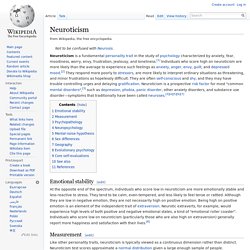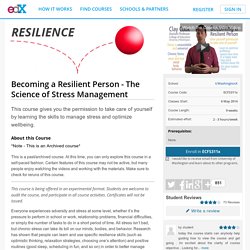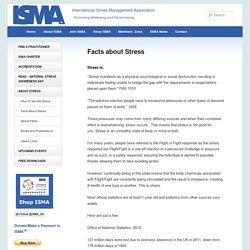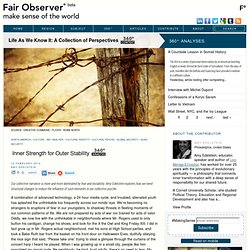

Neuroticism. Neuroticism. Emotional stability[edit] At the opposite end of the spectrum, individuals who score low in neuroticism are more emotionally stable and less reactive to stress.

They tend to be calm, even-tempered, and less likely to feel tense or rattled. Although they are low in negative emotion, they are not necessarily high on positive emotion. Being high on positive emotion is an element of the independent trait of extraversion. Neurotic extraverts, for example, would experience high levels of both positive and negative emotional states, a kind of "emotional roller coaster". Measurement[edit] Like other personality traits, neuroticism is typically viewed as a continuous dimension rather than distinct. Extent of neuroticism is generally assessed using self-report measures, although peer-reports and third-party observation can also be used. Statement measures tend to comprise more words, and hence consume more research instrument space, than lexical measures. Psychopathology[edit] Neuropsychology[edit] Becoming a Resilient Person - The Science of Stress Management. *Note - This is an Archived course* This is a past/archived course.

At this time, you can only explore this course in a self-paced fashion. Certain features of this course may not be active, but many people enjoy watching the videos and working with the materials. Make sure to check for reruns of this course. This course is being offered in an experimental format. Everyone experiences adversity and stress at some level, whether it’s the pressure to perform in school or work, relationship problems, financial difficulties, or simply the number of tasks to do in a short period of time. The purpose of this course is to teach individuals the science behind becoming a resilient person.
By the end of this course, you will have learned about the knowledge and skills that you can apply in your life now and in the future to be a resilient person. International Stress Management Association. “Stress manifests as a physical, psychological or social dysfunction resulting in individuals feeling unable to bridge the gap with the requirements or expectations placed upon them.”

PAS 1010 “The adverse reaction people have to excessive pressures or other types of demand placed on them at work.” HSE Those pressures may come from many differing sources and when their combined effect is overwhelming, stress occurs. This means that stress is not good for you. For many years, people have referred to the Flight or Fight response as the stress response but Flight/Fight is a one off reaction to a perceived challenge or pressure and as such, is a safety response, ensuring the individual is alerted to possible threats allowing them to take avoiding action.
However, continually being in this state means that the body chemicals associated with Flight/Fight are constantly being stimulated and the result is imbalance, creating ill health of one type or another. Here are just a few: Aviva 2011. Resilience: The Other 21st Century Skills. Due to the interest of my post The Other 21st Skills, I decided to individually discuss each of the skills or dispositions I proposed that are in addition to the seven survival skills as identified by Tony Wagner.

This post focuses on resiliency. The first post focused on Grit: The Other 21st Century Skills. Some would categorize Grit and Resiliency as the same skill, but it is my belief they are involve two different, but interconnected, skill sets. While grit focuses on persistence, resilience is about bouncing back in the face of challenges and/or failure. Some of characteristics or dispositions of Resilience include: Bouncing BackManaging EmotionsAwareness of Strengths and AssetsPassion-Driven FocusResourcefulnessSense of Personal AgencyAbility to Reach Out to OthersProblem-Solving Skills Resilience is the process of adapting well in the face of adversity, trauma, tragedy, threats or significant sources of stress.
Resilience research clearly reveals the following key points: Emotional Poise & Stability. “One's suffering disappears when one lets oneself go, when one yields―even to sadness.”

“It is only with one's heart that one can see clearly. What is essential is invisible to the eye.” — Antoine de Saint-Exupéry “Poise is just being yourself.” — John Wooden Our Emotions Defined Our emotions are multifaceted sensations that cannot be completely understood by our minds. Emotional poise is not the absence of “negative” emotions, no. Inner Strength for Outer Stability. Our collective narrative is more and more dominated by fear and instability.

Amy Edelstein explores how we need structural changes to reduce the influence of such elements in our collective psyche. A combination of advanced technology, a 24 hour media cycle, and troubled, alienated youth has splashed the unthinkable too frequently across our minds’ eye. We’re becoming no strangers to eruptions of fear in our youngsters, to shadowy threats in fleeting moments of our common patterns of life. We are not prepared by acts of war nor trained for acts of valor. Oddly, we now live with the unthinkable in neighborhoods where Mr. The unthinkable is in our cultural psyche. There are no doubt structural changes that we need to make to restrict access to instruments of violence. A deeper security in the face of the challenges of life comes from our own inner stability.
The views expressed in this article are the author's own and do not necessarily reflect Fair Observer’s editorial policy. Development of Emotional Stability Scale. Emotionally_Unstable_Spells_Trouble.pdf.